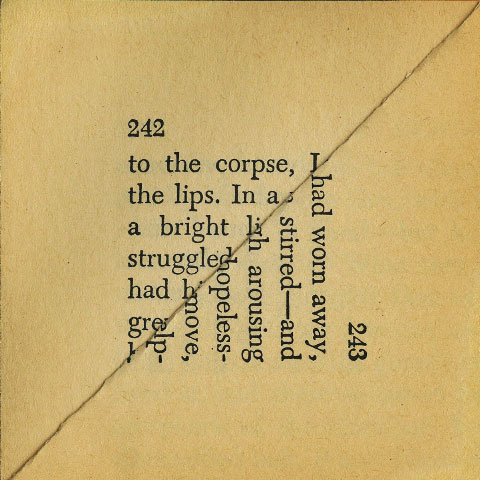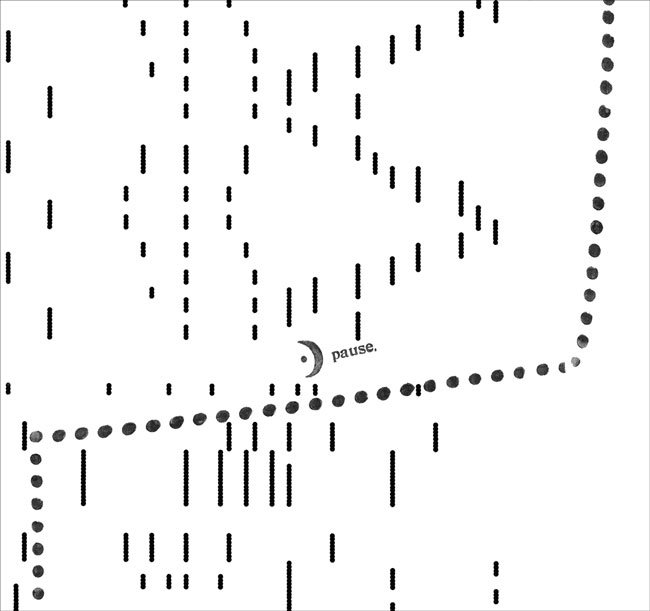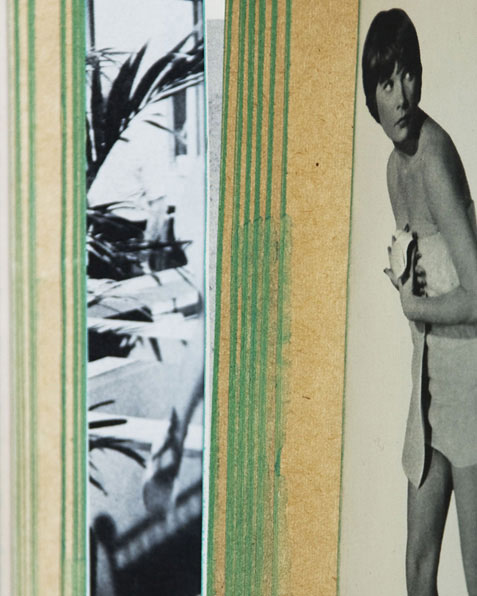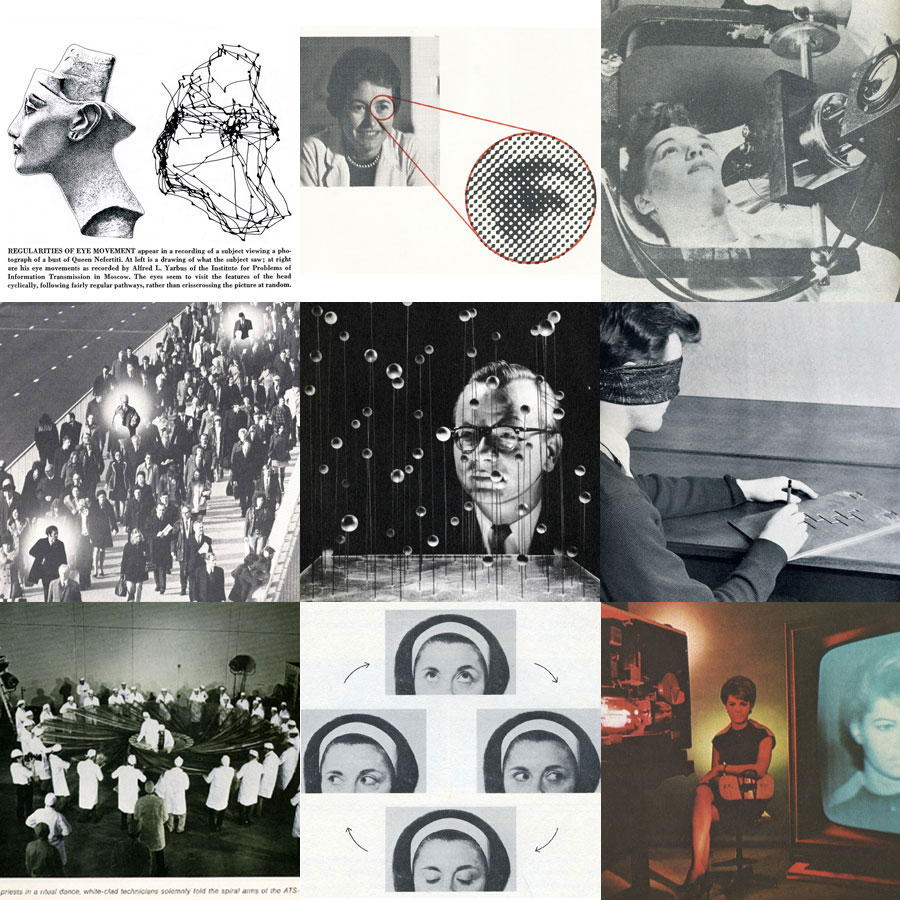In advance of the second program in The Drawing Center’s Drafts series, Communications Intern Daniel Peacock speaks with artist Erica Baum about her work with vintage books and other archival materials.
Daniel Peacock: Your latest projects, Naked Eye and Dog Ear, both begin with the book as a found material to be subjected to new ways of looking at a familiar object. In the Naked Eye series, the whole book is splayed to produce an abstracted composite, while Dog Ear juxtaposes two consecutive leaves through the common act of dog-earing a page. When locating material for these series, what are your methods and criteria?
Erica Baum: In choosing books for the Dog Ear series I’m tuning in to the variety of the fonts, the density of the words, and the texture and color of the yellowing pages. In order to make a dog ear complete I have to find a verbal rhythm that extends to every possible reading that the visual field suggests.
For the Naked Eye series I’m looking mainly but not exclusively at mass-market paperbacks. I’m interested in their brightly colored dyed edges and photographic content. The books are mainly biographies and movie tie-ins with a smattering of other non-fiction topics. Initially I made the Dog Ear works from my own books, later extending my search to used bookstores and thrift shops where I also look for potential Naked Eye books.

Erica Baum, Corpse (Dog Ear), 2009. Pigment print, 9 x 9 inches. Image courtesy of the artist and Bureau, New York.
DP: It appears that the Naked Eye series looks back to a defined era as it lives on in the pages of these paperbacks. What draws you to engage with that particular moment in time now?
EB: It’s not really about that time so much as the material production of that time. Current publications add an acid-free shinier gloss to the white page, which results in less texture and less detail in photographic reproduction. I prefer the earlier books with their dyed edges and cheap acidic paper so prone to yellowing and crumbling, typeset with old technology where letters sometimes are imperfectly struck and bounce along a not-so-straight line. If those sorts of books were in production today I’d be interested in what they might reveal about our current time too.
DP: You’ve said before that you consider the straight street photography of Evans, Atget, and Brassai as the starting point for your approach to photography. It strikes me that your process does mirror theirs in many ways, though your work operates on a much different scale. Do you see the public terrain of street photography as analogous to the textual materials you work with?
EB: Yes, that’s a good way of putting it. I’m treating objects as visual artifacts and framing landscapes from their textual and textural fields.
DP: In both the Dog Ear and the Naked Eye series, your intervention or gesture within the fixed form of the book is conspicuous but not uncomplicated. Your hand in the images that form your Roll Playing series is less openly discernible. Can you describe the transformation a piano roll takes in becoming one of your images?
EB: The rolls I worked with in that series combine perforated notations and rubber stamped song lyrics. By choosing to print the piano roll selections in high contrast black and white I emphasized the industrial nature of the mechanically reproduced musical performance. I was interested in the contrast that this experience provides between the cool nature of the flattened graphic field and the emotional and disembodied song lyric texts.

Erica Baum, Pause (Roll Playing), 2008. Digital C-print, 40 x 38 inches. Image courtesy of the artist and Bureau, New York.
DP: This flattened graphic field is one very familiar to us now—the frenzied digitalization of printed matter, the easily accessible online documentation of works in museum collections, the proliferation of digital photography, to point out a few examples, have become primary modes of encountering text and image for many. Viewing your work complicates this collective impulse by introducing reminders of the three dimensionality of the original and the experience of the object’s texture and dimensions. How do you see your relationship to the changing experience of relating to art and text?
EB: I started my photographic investigations with film and the darkroom before the proliferation of digital imagery. In making the choice to accentuate the flattened graphic field in my piano roll prints, I didn’t consider it such a familiar experience. Compared to the lush tones and extensive detail available with large format photography it was a stark and different choice.
I find it exciting that there are now so many different platforms for viewing and experiencing my work; it parallels our engagement with information in books, on the web, and in exhibition spaces.
DP: The Drawing Center’s Drafts Phase II: It Works Like This will continue the series with three new contributions based on images you selected from the Reanimation Library. What was your experience in selecting your suite of nine images and how did you decide what to include?
EB: My selection was developed around an image chosen by Kaegan Sparks in her selection for Drafts Phase I. The image shows eye-movement traces while a subject explores a picture of a bust of Nefertiti.
I was drawn to the images in the Reanimation Library that emphasized the relationship between the subject and the object, with attention to the subject’s gaze, often but not exclusively a woman’s gaze, veering off from the mechanics of movement into the psychology of identity, representation, and subjectivity. Then, in hoping to establish a visual rhythm that echoes the revolving nature of these inquiries, I chose images that highlight circles within circles, where the object becomes the subject and back again.
Drafts Phase II: It Works Like This is scheduled for March 12, 2013 at 6:30 PM. The program, based on images tracing lines of sight and connecting subjects and objects of perception selected by Erica Baum, will include three performances by artists Lauren Bakst, Shonni Enelow, and Steven Zultanski.
This week Erica Baum premieres a new benefit edition installed and featured in Printed Matter’s booth for the Independent. Also at the Independent, Bureau will present four of Erica Baum’s Piano Rolls alongside works by Tom Holmes and Viktor Kopp.


